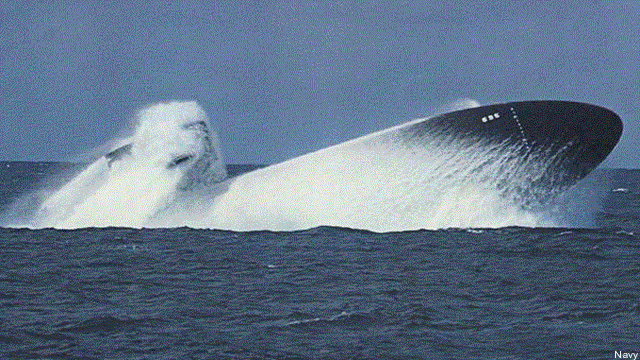Transparent Sea: The Unstealthy Future Of Submarines
Posted on

WASHINGTON: Submarines have been America’s invisible advantage since World War II. But the oceans are getting more transparent.
New detection technologies from low-frequency sonar to flashing LEDs — plus the big data computing power to enhance the faint signals they pick up — are making submarines much easier to detect. The same water-penetrating wavelengths, however, will also make it much easier for submarines to communicate with each other.

Bryan Clark
The net result should be radically new tactics, Bryan Clark, a career submariner and former top aide to the Chief of Naval Operations, says in a new study for the Center for Strategic and Budgetary Assessments out today. Instead of submarines operating alone and unafraid, he writes, they could operate together in underwater networks. Manned submarines would lurk out of missile range, 200 nautical miles from hostile shores, and serve as motherships for unmanned mini-subs and even aerial drones that push ahead into enemy “anti-access/area denial” defenses.
This networked force — a new wolf pack? — would take advantage of America’s lead in computing, communications, and autonomous systems — just as adversaries like Russia and China are starting to catch up on numbers and sophistication of submarines. If Clark’s approach to underwater warfare also sounds a lot like the mix of drones, stand-off, and wireless networks that’s come to characterize US operations in the air, that’s not an accident.
“The advent of improved sensors and processing will make below-water warfare more like warfare above the water,” Clark told me in an email. “In some ways [detection] may be easier — for example, a contact can be detected ‘over the horizon’ underwater because sound bends with the curvature of the earth,” unlike radar waves.
Big data is a big part of the new detection methods. Navies normally use active sonars with frequencies higher than 1,000 hertz, even though lower frequencies carry further, because lower frequencies require longer wavelengths that allow for less precision. With the right algorithms and plenty of computing power, however, you can refine a fuzzy picture to the point that low-frequency sonar becomes tactically useful. It’s similar to how improvements in processing power might make low-frequency radar able to target stealth aircraft.
Big data also enables more exotic techniques. Instead of standard sonar, sub-hunters could use lasers or even light from LEDs, carefully tuned to frequencies that carry best underwater. You could even eschew active sensing altogether and passively monitor changes in the ocean environment, such as changes in background noise from sea life or tiny ripples on the surface from a sub passing underneath. These indirect detection methods also have their anti-aircraft counterparts, where “passive radar” looks for stealth aircraft by analyzing disturbances in the background chatter of radio transmissions that are part of modern life.
Overall, the new methods for detecting submarines are “analogous to what is being pursued in the electromagnetic spectrum against stealthy and other aircraft,” Clark told me. In both air and water, he said, “the advantage provided by stealth will continue to diminish.”
That doesn’t mean submarines or F-35 fighters become irrelevant, however, because platforms without stealth features will fare far worse. Stealth will become the price of entry into the warzone, he explained, instead of a ticket to penetrate undetected into enemy defenses.
As a result, Clark said, we need to start combining stand-off and stealth: Keep the manned stealth platform at a distance — where it’s harder to detect and has more time to evade attack — and send in unmanned, relatively expendable, but also stealthy platforms to do the close-in tactical work. Larger drones and unmanned underwater vehicles (UUVs) would deploy on their own from surface ships, while smaller systems could be launched from the submarines themselves.
Coordinating all this would be an underwater communications network. “The same technological advancements that improve undersea sensors will also improve undersea communications,” Clark said. High-frequency sound waves, lasers, or LEDs could all provide high-bandwidth datalinks underwater — albeit at shorter ranges than radio waves in air — especially with enough computing power at the receiving end to sort signal from noise. Undersea cables or relays deployed on the sea floor could extend the network all the way back to US bases on land.
This kind of connectivity could be a culture shock for submarines, who traditionally go off for months where they don’t talk with anyone, including higher command. The surface fleet has long struggled with issues of independence, initiative, and micromanagement that could now extend underwater as well. Moving towards an underwater network will hardly be easy. With Clark’s work getting personal attention from senior admirals, however, his latest proposal is likely to be taken seriously.
Subscribe to our newsletter
Promotions, new products and sales. Directly to your inbox.
